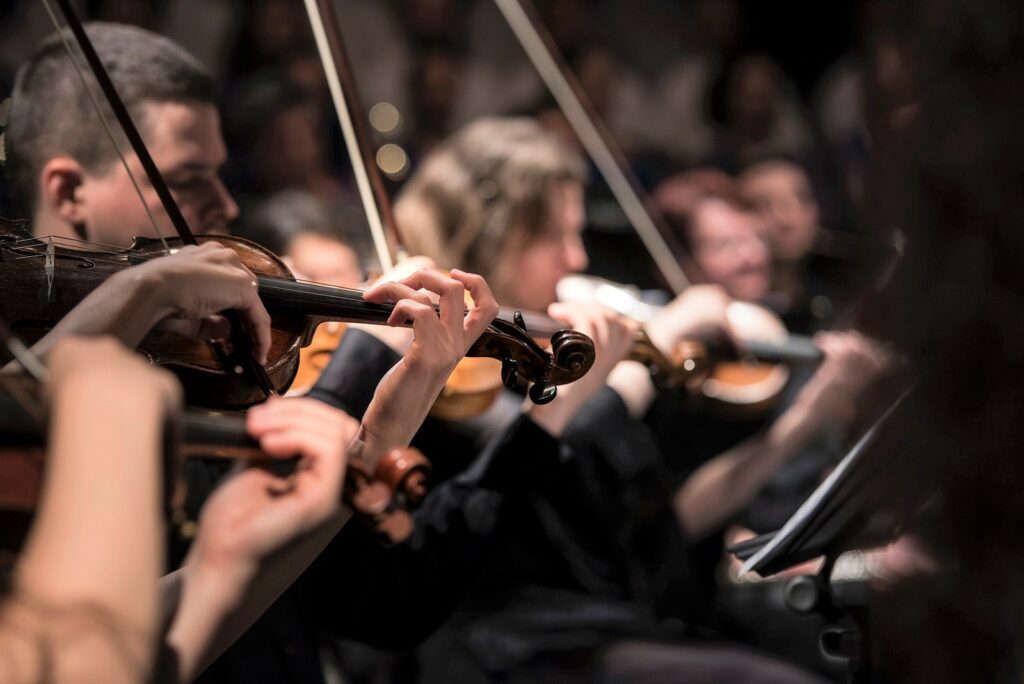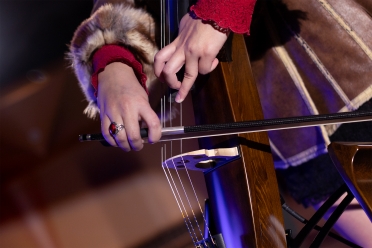New to Teaching Strings?
If you are new to teaching strings, don’t panic. Top string professionals offer advice as you launch into uncharted territory.
After years of teaching band, you must now teach beginning orchestra, too. Panic sets in as you realize you don’t know how to position your fingers, and you fear making screeching sounds in front of your students.
Switching to string education is not a rare occurrence. In fact, a 2008 study titled “Perception Differences of String-Trained and Non-String-Trained Educators Who Teach Strings in Iowa and Nebraska” found that nearly one-third of music educators in those states teaching string or orchestral classes were not native to the string family.
Here are five tips from seasoned strings educators that will enable you to effectively transition to become a first-rate string educator.
Tip 1: Learn the Instrument with Your Students

While teaching students to play a string instrument is a fundamentally different experience than teaching band or choir, the inherent externality of the instrument also has its advantages. “The act of playing a string instrument involves lots of large muscle movement in a way that the other two disciplines do not,” says Bob Phillips, director of string publications for Alfred Music Publishing and a former president of the American String Teachers Association (ASTA). “You can actually see the muscles that are moving and how they’re moving, so it’s much easier to identify what’s happening — although those movements are much more complex.”
Teaching string instruments “relies upon modeling and showing and demonstrating,” says Kirk Moss, chair of the department of music and theatre at the University of Northwestern-St. Paul in Minnesota. Therefore, he says that it’s particularly important for string educators to become proficient on at least one string instrument as quickly as possible in order to be able to teach with an instrument in hand.
While it may seem a little awkward at first, an effective way to continually improve on your own playing is in the classroom along with your students. Putting yourself in your students’ shoes will provide you with insight about their challenges. “The interesting thing from a pedagogical standpoint is when we have a secondary instrument in our hands, as a music educator, we’re processing that ourselves,” Moss says. “The same things that I might struggle with are the same things that my students might struggle with.”
Tip 2: Focus on the Bow Hand

Going back to the basic mechanics of the instrument with your string students may not be particularly glamorous, but it’s incredibly important as a retention tool. “If, fundamentally, the sound of the instrument isn’t good, they don’t like and enjoy playing,” says Phillips.
Moss recommends that teachers focus on the right hand. “The right hand and the bow arm are analogous to the breath of the singer,” he says. “At a very basic level, a lot of that comes down to the placement of the right thumb. As a general principle, the thumb and second finger on the right hand are opposite each other and should form a relaxed oval shape when holding the bow. Maintaining that bow and placement is kind of a cornerstone.”
In addition, teachers should help students get rid of tension in the bow hand by making sure the fingers curve naturally. Focusing on these little things will make a big difference in your students’ sound production. “The more we can work with the students’ bow hand, the better the sound,” Moss says.
Tip 3: Develop a Community of Resources

Integrating method books such as “Orchestra Expressions,” “Essential Elements for Strings” and “Sound Innovations” can provide a useful structure to map out the path your students will take throughout the year. Not only do these books include important information for students, but some also include useful tips for educators such as how to evaluate students, how to set up your orchestra room and more.
“Some of the lessons are so well scripted that if you’re prepared ahead of time, you can feel really confident,” says Nancy Campbell, orchestra director at the School for Creative and Performing Arts in Lexington, Kentucky, and at the Central Kentucky Youth Orchestra.
ASTA is another exceptional resource. With state chapters, regional conferences and a new mentorship program started in 2016, the opportunities to learn from exceptional educators throughout the string community are endless. “There’s a wealth of information, and there’s a wealth of people out there that really want to help and are really good role models for teachers,” Campbell says.
YouTube™ is also a great place to look for demonstration videos, both for your own sake and also for your students to watch.
Even special interest groups on Facebook can be a powerful way to get teaching tips from other educators. Campbell belongs to Kentuckians for the Arts and Violas on the Verge, among others.
THE YAMAHA EDUCATOR NEWSLETTER: Energize your creativity as you build your music program!
Tip 4: Find a Mentor
Developing a community of string professionals that you can turn to with questions will prove extremely useful if you’re not native to the string family. Darryl Gregory, a trombonist turned string educator at Schaghticoke Middle School in New Milford, Connecticut, believes string mentors are especially useful for teachers in more remote locales or districts without a large string program. “Even if it’s not a mentor that’s local but just somebody that you can call up or you can email or FaceTime®, it can be a really good resource.”
Don’t know how to begin looking for a mentor? Universities and music stores are great places to jump-start your search.
Tip 5: Stay Optimistic
Even though teaching an unfamiliar subject may feel like an insurmountable task, try not to view it as such. Before you can be an effective teacher, you need to let go of your reservations. “Even if you can’t make a decent sound on a string instrument, you can still demonstrate and hold the instrument correctly and show how it should be held properly,” says Gregory.
Equally important is staying positive and enthusiastic, regardless of the circumstances. In the end a teacher’s purpose is to make a difference in their students’ lives. “If you can help kids to just be happy with where they are at this moment and work hard, I think that’s probably the biggest thing,” Campbell says.
Tip 6: Keep Learning

When Gregory took over at Schaghticoke Middle School in 2012 after nearly 30 years in band education, he had to take on a new role as the orchestra teacher, a challenge he faced head on. “I borrowed a cello and violin from my school, and I tried to do as best I could over the summer, at least getting familiar with the beginning aspects of teaching strings to be prepared for the beginning of the school year.”
Although Gregory’s first year as an orchestra teacher was successful, it was not until he took a pedagogy class the following summer that he realized just how unique orchestral education is. “It was eye-opening; there were things that I had no idea about that made me feel like I didn’t know anything about strings,” he says.
Gregory walked away from this class armed with new information about bow grip, the proper way to tell a child how to hold the instrument and a deeper understanding of string instruments in general. Since then, he has continued to learn and evolve as an orchestra educator.
“I’m still researching and thinking about things and looking at different ways of telling kids to do a certain bowing or a certain way of approaching the music.”
Top Photo by Jordan Mixson on Unsplash
Photos courtesy of Alfred Music Publishing, University of Northwestern-St. Paul, School for Creative and Performing Arts and Schaghticoke Middle School.
This article originally appeared in the 2017 V1 issue of Yamaha SupportED. To see more back issues, find out about Yamaha resources for music educators, or sign up to be notified when the next issue is available, click here.

















